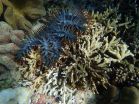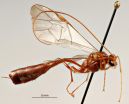To know the enemy
2014-12-15
(Press-News.org) This news release is available in Japanese.
New research published in the journal genesis, by Kenneth Baughman, Dr. Eiichi Shoguchi, Professor Noriyuki Satoh of the Marine Genomics Unit at the Okinawa Institute of Science and Technology Graduate University, and collaborators from Australia, reports an intact Hox cluster in the Crown of Thorns starfish, Acanthaster planci. This surprising result contrasts with the relatively disorganized Hox cluster found in sea urchins, which are also echinoderms, classification of animals including starfish, sea lilies, and sea cucumbers. Stanford University Professor Christopher Lowe, who studies developmental biology in echinoderms, summarizes the paper: "The translocation of the Hox cluster in echinoderms has been a major red herring for understanding their evolution. It's really good to have some hard data showing that some echinoderms exhibit some oddities that are not representative of all echinoderms."
The Hox cluster is a classic example of an 'evo-devo' genetic toolkit. The term "evo-devo" refers to the study of genetic programs that control development, which can be compared between species, and thus, across evolutionary time. The Hox genes coordinate segmental identity along the head to tail (anterior-posterior) axis. The Hox cluster is evolutionarily conserved and has been repurposed repeatedly during the evolution of the animal body plan, or how animals are shaped. Past studies have shown that Hox clusters organize the development of brain and central nervous system regions in chordates, limb bud identity in vertebrates, and, classically, antennae or wing segment identity in fruit flies.
Generally, the Hox cluster shows "colinearity," in which gene order correlates with the location of expression, or the developmental stage of expression. "For example, anterior Hox genes are expressed in regions that are closer to the head of an embryo, and are expressed sooner during development, versus the posterior Hox genes," explained Baughman. "Thus, we were surprised to see chordate-like Hox cluster organization in starfish, which have a radial body plan." Echinoderms are classical model organisms for embryology, and more recently evo-devo. Baughman added, "Interacting with the speakers and students of the OIST Winter Course 'Evolution of Complex Systems' (OWECS) allowed me to appreciate the importance of finding an intact Hox cluster in starfish."
The Crown of Thorns starfish, a predatory starfish which feeds on corals, is famous for its dramatic changes in population density on the reefs near Australia, as well as Okinawa. Over the past 50 years, this has resulted in a measurable loss of coral reefs. A recent 27-year reef monitoring study of the Great Barrier Reef estimated that the starfish accounts for 42% of the loss in coral cover, 2nd only to typhoons. While population control was the initial motivation for Crown of Thorns genome research, the Hox cluster report is one of the first to show that the species can be useful for studies in evolutionary-developmental biology. "We were excited to see the entire Hox cluster on a single genomic scaffold, a result which confirmed the remarkably high quality of the genomic data," said Prof. Satoh.
As is often the case with science, the discovery raises more questions than it answers. If starfish have a collinear Hox cluster, what accounts for their dramatic departures in body plan organization? Do starfish express Hox genes during development in a manner similar to chordates, as indicated by the organization of their Hox cluster? Baughman looks forward to addressing these questions and many more as part of his doctoral research. "I look forward to pursuing developmental biology studies that may suggest methods for mitigating damage to the coral reef caused by the Crown of Thorns starfish."
More research is being conducted at OIST on the Crown of Thorns starfish in the Marine Biophysics Unit by Masako Nakamura in cooperation with local fishermen. In addition to the research collaboration highlighted by the Hox publication, recent efforts by the Okinawa Prefectural Government and Australian Institute of Marine Science are also working on projects to protect the existing coral reefs from the Crown of Thorns starfish.
INFORMATION:
ELSE PRESS RELEASES FROM THIS DATE:
2014-12-15
SALT LAKE CITY, Dec. 15, 2014 -- Because of undetected toxicity problems, about a third of prescription drugs approved in the U.S. are withdrawn from the market or require added warning labels limiting their use. An exceptionally sensitive toxicity test invented at the University of Utah could make it possible to uncover more of these dangerous side effects early in pharmaceutical development so that fewer patients are given unsafe drugs.
To prove the point, the U researchers ran their test on Paxil, an antidepressant that thousands of pregnant women used in the years ...
2014-12-15
The same species of monkeys located in separate geographic regions use their alarm calls differently to warn of approaching predators, a linguistic analysis by a team of scientists reveals. The study, which appears in the journal Linguistics and Philosophy, reveals that monkey calls have a more sophisticated structure than was commonly thought.
"Our findings show that Campbell's monkeys have a distinction between roots and suffixes, and that their combination allows the monkeys to describe both the nature of a threat and its degree of danger," explains the study's lead ...
2014-12-15
CAMBRIDGE, MA -- A new study from MIT implicates a family of RNA-binding proteins in the regulation of cancer, particularly in a subtype of breast cancer. These proteins, known as Musashi proteins, can force cells into a state associated with increased proliferation.
Biologists have previously found that this kind of transformation, which often occurs in cancer cells as well as during embryonic development, is controlled by transcription factors -- proteins that turn genes on and off. However, the new MIT research reveals that RNA-binding proteins also play an important ...
2014-12-15
In 1912, three species in the parasitic wasp genus Ophion were described by two different entomologists, increasing the number of known species in North America to eleven. It has long been known that the actual diversity is much higher; however, it took 102 years for any additional species to be described.
"The main reason for this is that everyone has assumed that Ophion are just too difficult to tell apart. Museum collections are full of unidentified Ophion, but nobody has wanted to face the challenge of sorting them out" said Marla Schwarzfeld, an entomologist who ...
2014-12-15
CAMBRIDGE, Mass., December 15 -- Scientists at The Forsyth Institute and Tufts University have succeeded in describing and validating a unique system of oral vaccine delivery using a common bacteria found in the mouth. Findings published today by Elsevier in Microbes and Infection identify Streptococcus mitis as a successful vector for oral mucosal immunization, and further research will determine its potential clinical use in tuberculosis vaccine development.
"Although injected vaccines are traditionally viewed as effective means of immunization to protect internal organs, ...
2014-12-15
The sudden appearance of a face within our visual field can affect the motor action accompanying a gesture even if the face is totally unrelated to what we are doing and even if we try to ignore it. At one condition, though: the face must display an emotionally significant expression. A study conducted by scientists of the International School for Advanced Studies in Trieste, and just published in Psychonomic Bullettin & Review, describes the phenomenon in detail.
Many are the things that can influence our actions at the motor level. Among them, a particularly effective ...
2014-12-15
New Rochelle, NY, December 15, 2014-Adiponectin, a collagen-like protein secreted by fat cells, derives from the ADIPOQ gene. Variations in this gene may increase risk for type 2 diabetes, cardiovascular disease, and various cancers. A new study that links specific variations in the ADIPOQ gene to either higher or lower colorectal cancer risk is published in Genetic Testing and Molecular Biomarkers, a peer-reviewed journal from Mary Ann Liebert, Inc., publishers. The article is available on the Genetic Testing and Molecular Biomarkers website until January 11, 2014.
Xin ...
2014-12-15
Since August 2014, aflibercept (trade name Eylea) has been available also for patients with visual impairment due to diabetic macular oedema (DMO). The German Institute for Quality and Efficiency in Health Care (IQWiG) examined in a dossier assessment whether this drug offers an added benefit over the appropriate comparator therapy.
According to the findings, an added benefit in this therapeutic indication is not proven: The data showed no relevant differences between the treatment groups for patients in whom the fovea centralis is also affected. The drug manufacturer ...
2014-12-15
Squid, what is it good for? You can eat it and you can make ink or dye from it, and now a Penn State team of researchers is using it to make a thermoplastic that can be used in 3-D printing.
"Most of the companies looking into this type of material have focused on synthetic plastics," said Melik C. Demirel, professor of engineering science and mechanics. "Synthetic plastics are not rapidly deployable for field applications, and more importantly, they are not eco-friendly."
Demirel and his team looked at the protein complex that exists in the squid ring teeth (SRT). ...
2014-12-15
The team from The University of Nottingham and Queen Mary University of London, spent ten months studying to the ways cows communicate with their young, carefully examining acoustic indicators of identity and age.
They identified two distinct maternal 'calls'. When cows were close to their calves, they communicated with them using low frequency calls. When they were separated - out of visual contact - their calls were louder and at a much higher frequency.
Calves called out to their mothers when they wanted to start suckling. And all three types of calls were individualised ...
LAST 30 PRESS RELEASES:
[Press-News.org] To know the enemy







